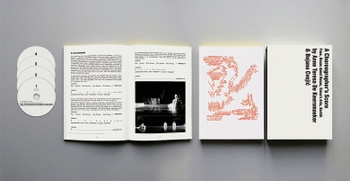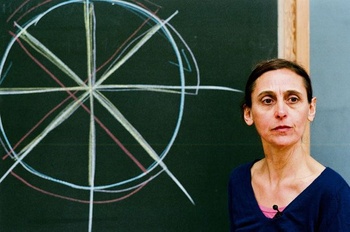In A Choreographer’s Score: Fase, Rosas danst Rosas, Elena’s Aria, Bartók, Anne Teresa De Keersmaeker takes a look at the genesis and foundations of her “early works”. Diagrams, photographs, working notes, and DVDs with excerpts from shows illustrate the points she makes.
BOOK/DVD | A Choreographer’s Score: Fase, Rosas danst Rosas, Elena’s Aria, Bartók ●●●
Anne Teresa De Keersmaeker & Bojana Cvejic Mercatorfonds, 252 p. + 4 DVDs (EN, subtitles in NL & FR), €49,95
“When you ask a child ‘what is dance?’ what will its answer be? Generally, the first reaction, or what the child would demonstrate, is turning. The second thing the child will do is jump. When children dance, they mostly turn with their hands. So if we say that dance is about turning, it’s about jumping, and it’s about moving arms. We could also say that this is what Fase is about...”
That was how Anne Teresa De Keersmaeker described, to the musicologist/performance theoretician Bojana Cvejic, the starting points for the movement material of Fase, the choreography that marked her big breakthrough in 1982. The statement was typical of the choreographer’s approach: the love of simple fundamentals, out of which a great complexity gradually crystallises, and the quest for an original dance idiom. That quest is extensively documented in A Choreographer’s Score. An austerely but originally presented reference work, it is in two main, interacting parts. There is a book, in which Cvejic and De Keersmaeker talk about the genesis and construction of her first four works, which caused a sort of earthquake in the dance scene: Fase, Rosas danst Rosas, Elena’s Aria, and Bartók. The book is also packed with extremely meticulous diagrams by the choreographer herself, early reviews and photographs, programme booklets, and even an audacious letter to the then culture minister, among other things.
Then there is a lot of fascinating visual material on four DVDs, one per show, offering a total of 5 hours and 54 minutes of viewing! In addition to excerpts from the shows, we regularly see De Keersmaeker on a chair beside an old blackboard. The setting makes it clear: this is going to be a “class” in contemporary dance practice. Her straightforward and at times quite disarming narrative style – combined with Cvejic’s pertinent questioning – ensures that you pay attention. In fact you become the astounded witness of how an artistic life’s work developed step by step and of the way De Keersmaeker went about things: exceptionally well-thought-out, even mathematical, but at the same time intuitive. Occasionally she can’t resist dancing a movement phrase in illustration: these are beautiful, fragile moments, in part because sometimes she is wearing heavy walking shoes so that it almost becomes a performance in itself.
Rosas revisited


(© Anne Van Aerschot)
It is exactly ten years since the last Rosas publication: Rosas/Anne Teresa De Keersmaeker. Als en slechts als verwondering – published on the occasion of the exhibition of the same name – was a splendid book of photographs of a rich oeuvre. The approach taken in A Choreographer’s Score is quite different: from the inside, and in depth, so that it is somewhat reminiscent of the peeling of an onion, layer by layer…until finally one arrives at that courageous young girl from Wemmel who was so keen to dance that she reinvented dance.
It is exactly ten years since the last Rosas publication: Rosas/Anne Teresa De Keersmaeker. Als en slechts als verwondering – published on the occasion of the exhibition of the same name – was a splendid book of photographs of a rich oeuvre. The approach taken in A Choreographer’s Score is quite different: from the inside, and in depth, so that it is somewhat reminiscent of the peeling of an onion, layer by layer…until finally one arrives at that courageous young girl from Wemmel who was so keen to dance that she reinvented dance.
Fijn dat je wil reageren. Wie reageert, gaat akkoord met onze huisregels. Hoe reageren via Disqus? Een woordje uitleg.